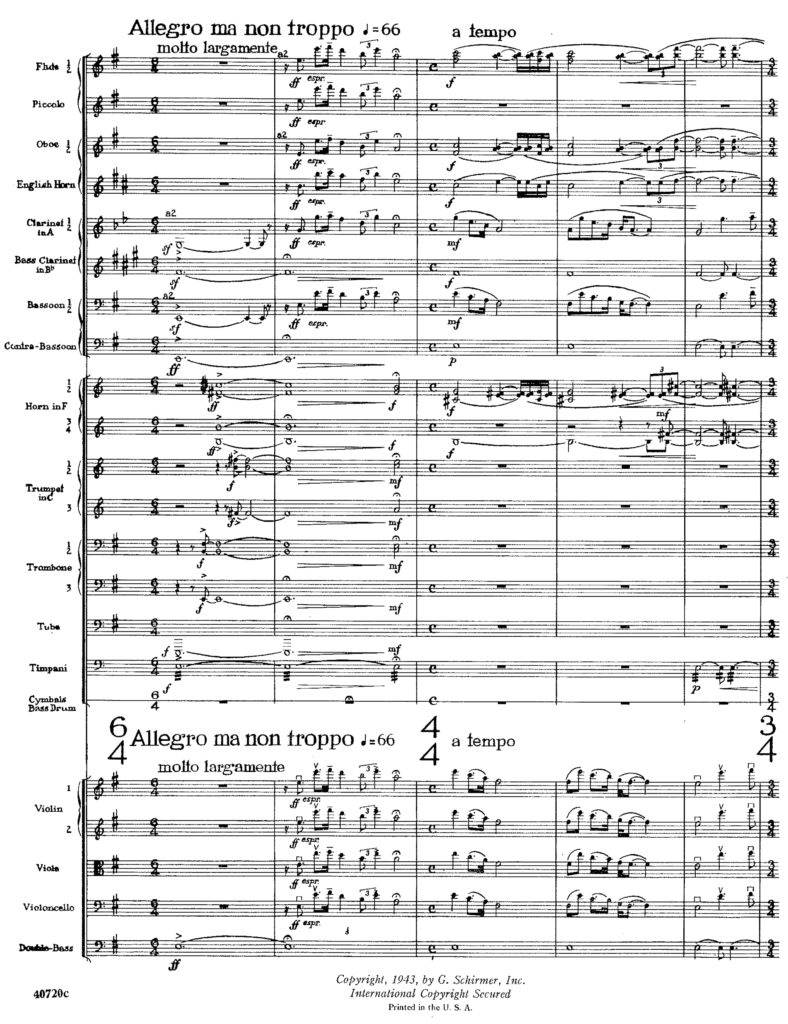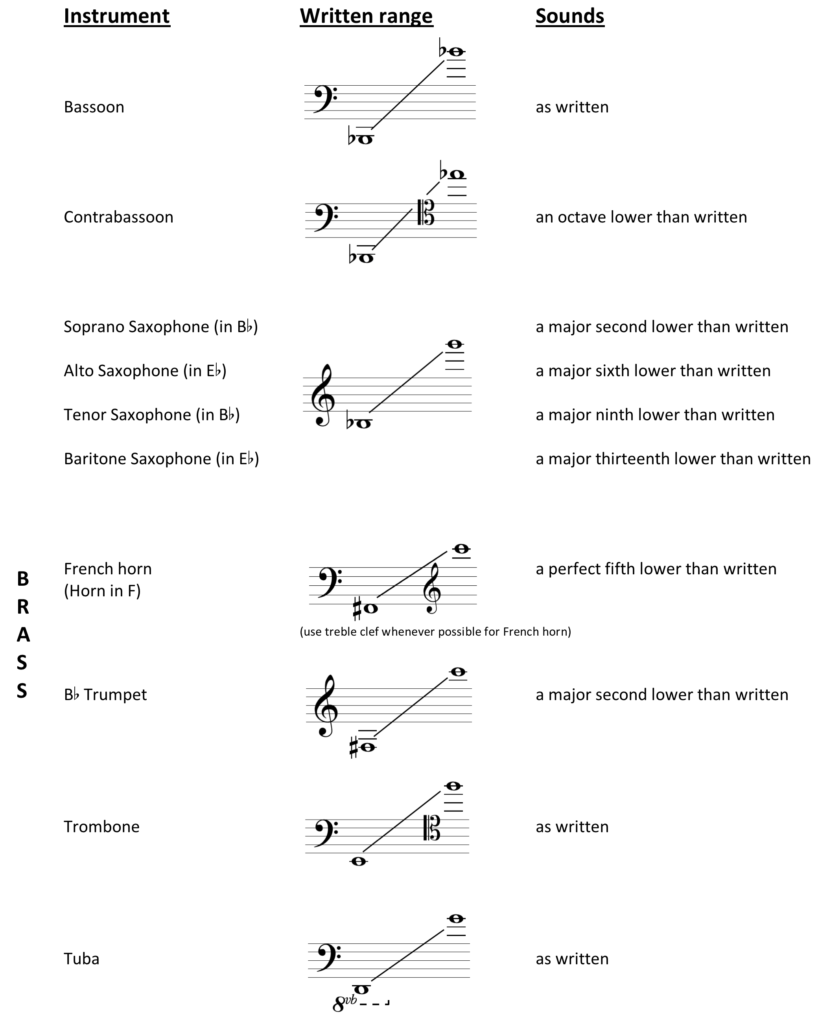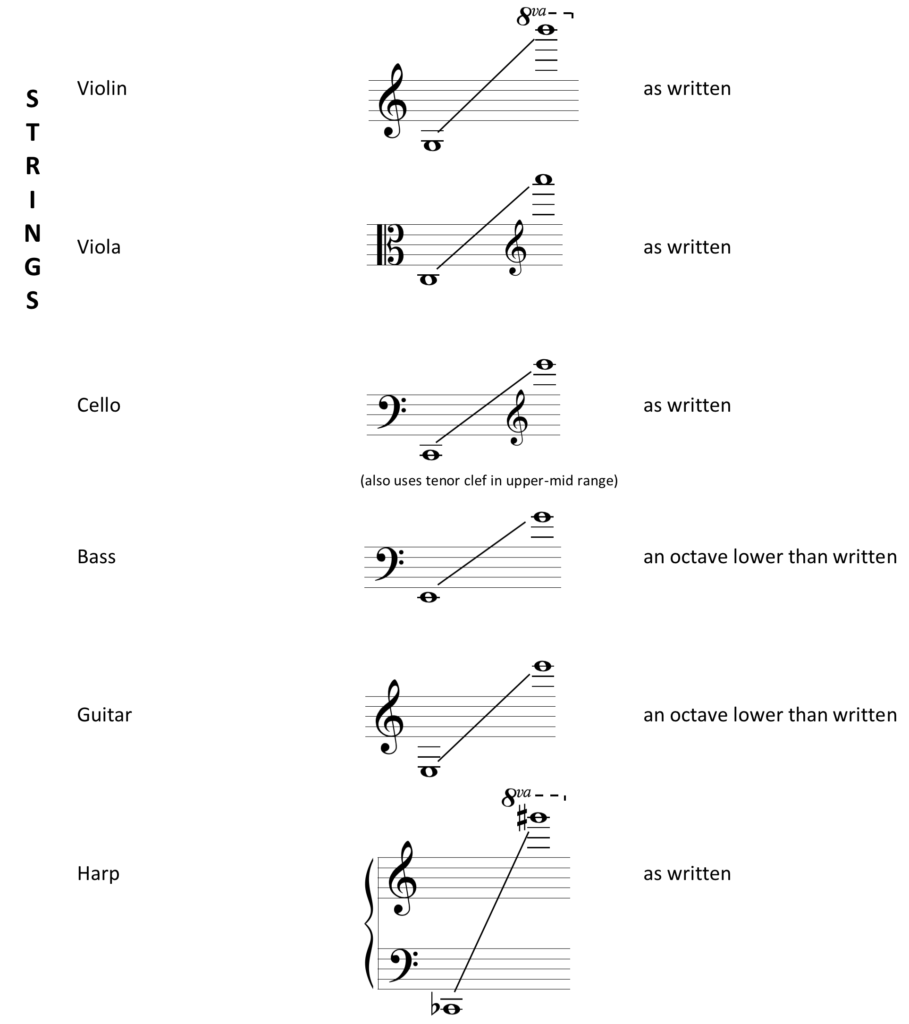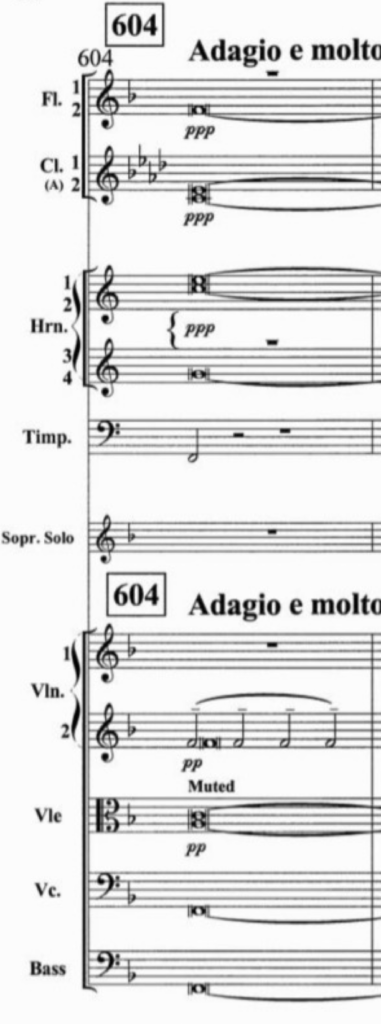Main Body
28 Instrument transpositions and ranges
Learning goals for Chapter 28
In this chapter, we will learn:
- What instruments are (meaning they sound at the pitch notated)
- What instruments are transposing (meaning they sound at a different pitch than notated)
- To read parts—translating what we see into what we hear, so that we can read full orchestral scores
- To understand how to write music for transposing instruments—translating what we want to hear into what the player needs to see
In this chapter, we are learning more about instruments, focusing on “” and their ranges. A transposing instrument is one where the musician reads one pitch and we hear another—so, depending on the instrument, a C on the page may sound as a different note altogether. This chapter will teach you how to interpret and write transposed parts effectively. If this topic is brand new to you, you might find it confusing at first. Before moving on, consider watching the video below, which presents a fast-paced, exciting introduction to the topic.
Video: Brad Harrison’s video “Concert Pitch and Transposing Instruments” (6:52)
This fast-paced and exciting video introduces the concept of transposing instruments and how they work.
Instrument ranges and transpositions
Each instrument has its own special properties, including a distinct and range. Notation for each instrument varies in terms of what clefs and transpositions are commonly used. Figure 28-1 summarizes the ranges and transpositions for many common instruments. The figure is organized into instrument families—woodwinds, brass, and strings—presented in the order we encounter thes in an orchestral score.
Figure 28-1. Ranges and transpositions for common instruments
We refer to the sounding pitch we hear, regardless of how it is notated, as “.”
You may find it helpful to think of instruments not only as grouped together by their instrument families (woodwinds, brass, and strings), but also in terms of which instruments transpose and by what interval.
For example, of the instruments listed above, we can identify several groups:
- F instruments: English horn, French horn
- B
 instruments: clarinet in B
instruments: clarinet in B , bass clarinet, soprano saxophone, tenor saxophone, B
, bass clarinet, soprano saxophone, tenor saxophone, B trumpet
trumpet - A instrument: clarinet in A
- E
 instruments: alto saxophone, baritone saxophone
instruments: alto saxophone, baritone saxophone - C instruments written an octave lower than they sound: piccolo
- C instruments written an octave higher than they sound: contrabassoon, bass, guitar
All other instruments that appear in this guide are with no transposition. Additionally, it may be helpful to remember that all transposing instruments, except for the piccolo, sound lower than they are written.
EXERCISE 28-1 Analysis of Samuel Barber’s First Symphony, op. 9, mm. 1–5
Study the first page of the score for Samuel Barber’s First Symphony and listen to the beginning of the movement. Then answer the questions below.
Worksheet example 28-1. Samuel Barber, First Symphony, op. 9, mm. 1–5

By Samuel Barber
Copyright © 1943 (Renewed) by G. Schirmer, Inc. (ASCAP)
International Copyright Secured. All Rights Reserved.
Used by Permission.
Listen to the full track, performed by the Saint Louis Symphony orchestra, conducted by Leonard Slatkin, on Spotify.
Learn about American composer Samuel Barber (1910–1981) by reading this Oxford Music Online article, written by Barbara B. Heyman.
EXERCISE 28-2 Writing for transposing instruments
Study the following passage written in concert pitch, and answer the questions that follow.
1) What concert-pitch key is this passage in?
Now, consider the following instruments:
CLARINET IN B![]()
2) If you wanted clarinet in B-flat to play this passage, what key would it be written in?
3) What clef would be used?
VIOLA
4) If you wanted violas to play this passage, what key would it be written in?
5) What clef would be used?
ALTO SAXOPHONE
6) If you wanted alto sax to play this passage, what key would it be written in?
7) What clef would be used?
HORN IN F
8) If you wanted horn in F to play this passage, what key would it be written in?
9) What clef would be used?
Finally, on a piece of staff paper, notate the passage for each of these instruments so that when played it will sound at concert pitch.
EXERCISE 28-3 Analysis with transposing instruments in Hailstork’s Done Made My Vow
Previously we studied an excerpt from Hailstork’s massive oratorio Done Made My Vow for the composer’s treatment of text setting. This next exercise will involve looking at a single measure from the orchestral score to apply our knowledge of transposing instruments. Study Worksheet example 28-2 and answer the questions below.
This section is scored for two flutes (Fl.), two clarinets (Cl.) in A (not B![]() ), four horns (Hrn.) in F, timpani (Timp.), soprano solo, and strings–violins (Vln.), violas (Vla.), cellos (Vc.), and double basses (bass).
), four horns (Hrn.) in F, timpani (Timp.), soprano solo, and strings–violins (Vln.), violas (Vla.), cellos (Vc.), and double basses (bass).
- What concert pitch key does this excerpt start in?
- What is the concert pitch and for the first clarinet at m. 604?
- What is the concert pitch and octave designation for the second clarinet at m. 604?
- What is the concert pitch and octave designation for the first horn at m. 604?
- What is the concert pitch and octave designation for the second horn at m. 604?
- What is the concert pitch and octave designation for the fourth horn at m. 604?
- What is the relationship between the concert pitches of the viola parts and the clarinet parts?
- What is the concert pitch and octave designation for the cellos at m. 604?
- What is the concert pitch and octave designation for the double bass at m. 604?
Worksheet example 28-2. Adolphus Hailstork, Done Made My Vow, m. 604
Done Made My Vow
By Adolphus Hailstork
Copyright © 1985 by Theodore Presser Company.
All rights reserved. Used with Permission.
Listen to the full work, performed by Baltimore Symphony Orchestra and Morgan State University Choir, conducted by Danial Hege and Nathan Carter, on YouTube.
Learn about American composer Adolphus Hailstork (b. 1941) by reading this Oxford Music Online article, written by Doris Evans McGinty.
Supplemental resources for Chapter 28
instrument that sounds at the pitch in which it is notated
instrument that sounds at a different pitch than notated
"the perceptual quality of sound” (Eidsheim 2008, 158)
the sounding pitch we hear, regardless of how it is notated
system that allows us to differentiate among different octave placements of the same letter name (e.g., C4 refers to middle C; A4 refers to the A above middle C, while A3 refers to the A below middle C)





